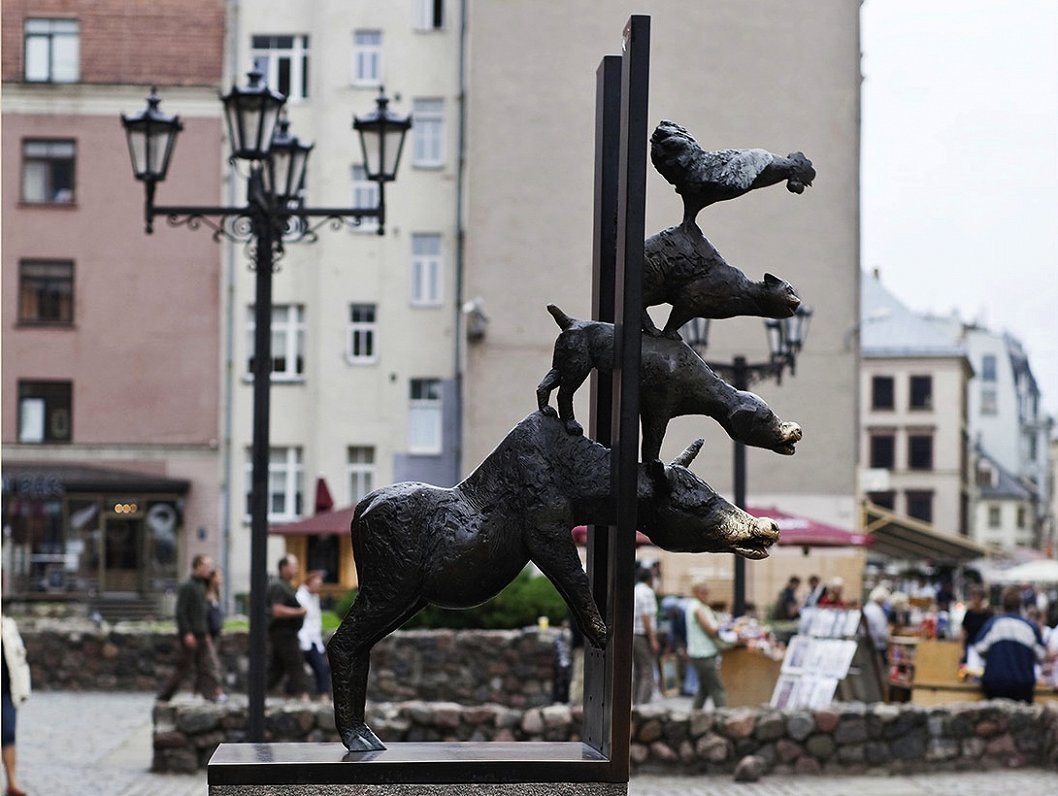In the Latvian capital, the Bremen Musicians are not spying on a robbers’ feast. In Rīga, the donkey, dog, cat and rooster are squinting to see through the Iron Curtain. This unusual bronze statue is a 1990 gift by Bremen to its sister city Rīga, and it arrived in the former Latvian SSR at a time of change. The German Hanseatic city made use of the opportunities arising from Mikhail Gorbachev’s policy of glasnost and perestroika. Thus the famous musicians became harbingers and witnesses of Latvia’s renewed independence.
This work by German artist Christa Baumgärtel (1947) was set up in Old Rīga right by St. Peter’s Church. Each day, hundreds of tourists pass the sculpture, which stands taller than an average human being. Chancellor Angela Merkel, too, made a short stop at the sculpture during her 2010 visit in Rīga. Rubbing the animals’ noses is supposed to bring luck and fulfil wishes, and that’s the reason why they gleam, polished as they are by the many touches of passersby.
Many are familiar with the fairy tale about the four aging animals that left their home to become town musicians in Bremen. It was first written down by the Brothers Grimm in the early 19th century. Translated into different languages, this animal tale became known across the world, including in Latvia with the title “Bremen Musicians” (Brēmenes muzikanti).
But the statue is not a mere carrier of political subtext. It also symbolizes the long-standing relations between two Hanseatic cities. Rīga was founded in 1201 by Albert von Buxthoeven, the Bishop of Bremen. Since then, the city has maintained close economic ties with Bremen. There was even a Bremen Consulate working intermittently in the Baltic metropolis during the 19th century. The active cooperation between the cities, maintained up to this day, became a symbol of agreement between the peoples of the East and the West when the cities signed the twinning agreement in 1985.
But not just the Bremen Musicians are responsible for making Bremerinnen feel at home in Rīga. Wandering through the narrow streets of the old town, one can encounter many historical parallels to the German twin city on the banks of the Weser River. There’s a statue of Roland by the City Halls in both cities, symbolizing the town’s privilege to administer justice, as well as its independence, freedom and trading rights. It’s also a symbol of Bremen. Likewise, the coats of arms of both cities feature the keys to heaven, an attribute of the towns’ guardian St. Peter. Members of the historical German trading association – “the Rīga Brotherhood of Blackheads” – found their new home in the Bremen Schütting after forced relocation to Germany in 1939. The magnificent House of Blackheads in Rīga is the brotherhood’s erstwhile home.
Initially, a different location was conceived for the statue of the Bremen Town Musicians, the counterpart of which, the work of Gerhard Marcks (1889-1982), was placed by the Bremen City Hall in 1953. There was a plan to create a Park for Friendship, authored by Rīga’s twin cities, on one of the islands of the River Daugava. But it never came to fruition, and thus these rays of sunshine from Bremen were allocated a prominent place in the Old Town.
You can see more of Rīga's many public monuments and sculptures at the Rīga Monument Agency website.
The German Traces series was first published as part of the Goethe Institut in Rīga project “German Footprints in Latvia” ("Vācu pēdas Latvijā" www.goethe.de/vacu-pedas). The linked mobile application "German Footprints in Latvia" can be downloaded at www.ej.uz/vp-iOS and www.ej.uz/vp-Android.



























